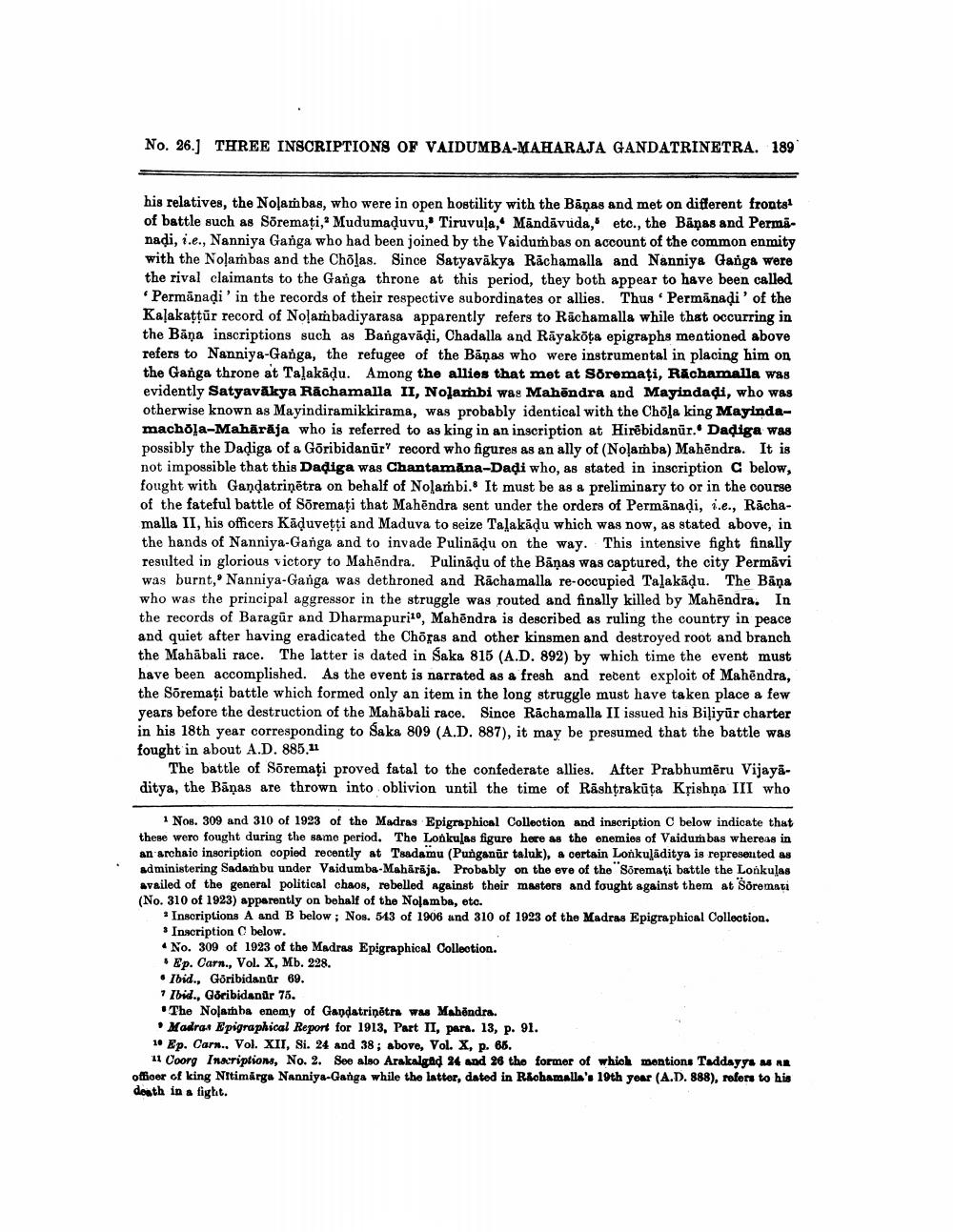________________
No. 26.) THREE INSCRIPTIONS OF VAIDUMBA-MAHARAJA GANDATRINETRA. 189
his relatives, the Nolambas, who were in open hostility with the Bānas and met on different frontal of battle such as Söremați, Mudumaduvu, Tiruvula, Mändāvuda, etc., the Baņas and Permanadi, i.e., Nanniya Ganga who had been joined by the Vaidumbas on account of the common enmity with the Nolambas and the Cholas. Since Satyaväkya Răchamalla and Nanniya Ganga were the rival claimants to the Ganga throne at this period, they both appear to have been called
Permānadi' in the records of their respective subordinates or allies. Thus. Permanadi' of the Kaļakattur record of Noļambadiyarasa apparently refers to Rāchamalla while that occurring in the Bāņa inscriptions such as Bangavādi, Chadalla and Rayaköţa epigraphs mentioned above refers to Nanniya-Ganga, the refugee of the Bāņas who were instrumental in placing him on the Ganga throne at Talakādu. Among the allies that met at Söremați, Răchamalla was evidently Satyavākya Rāchamalla II, Nolambi was Mahēndra and Mayindadi, who was otherwise known as Mayindiramikkirama, was probably identical with the Chola king Mayindamachola-Mahārāja who is referred to as king in an inscription at Hirēbidanūr.. Dadiga was possibly the Dadiga of a Gõribidanūr' record who figures as an ally of (Noļamba) Mahēndra. It is not impossible that this Dadiga was Chantamāna-Dadi who, as stated in inscription C below, fought with Gandatrinētra on behalf of Nolambi. It must be as a preliminary to or in the course of the fateful battle of Söremaţi that Mahēndra sent under the orders of Permānadi, i.e., Rachamalla II, his officers Kāduvetti and Maduva to seize Talakādu which was now, as stated above, in the hands of Nanniya-Ganga and to invade Pulinādu on the way. This intensive fight finally resulted in glorious victory to Mahēndra. Pulinādu of the Bāņas was captured, the city Permāvi was burnt, Nanniya-Ganga was dethroned and Rāchamalla re-occupied Talakādu. The Bāņa who was the principal aggressor in the struggle was routed and finally killed by Mahendra. In the records of Baragür and Dharmapuri 0, Mahendra is described as ruling the country in peace and quiet after having eradicated the Choras and other kinsmen and destroyed root and branch the Mahabali race. The latter is dated in Saka 815 (A.D. 892) by which time the event must have been accomplished. As the event is narrated as a fresh and recent exploit of Mahēndra, the Söremaţi battle which formed only an item in the long struggle must have taken place a few years before the destruction of the Mahābali race. Since Rāchamalla II issued his Biliyūr charter in his 18th year corresponding to Saka 809 (A.D. 887), it may be presumed that the battle was fought in about A.D. 885.11
The battle of Söremati proved fatal to the confederate allies. After Prabhumēru Vijayaditya, the Bānas are thrown into oblivion until the time of Rashtrakūta Krishna III who
1 Nos. 309 and 310 of 1923 of the Madras Epigraphical Collection and inscription C below indicate that these wero fought during the same period. The Lonkulas figure here as the enemies of Vaidumbas whereas in an archaic inscription copied recently at Tsadamu (Punganūr taluk), a certain Lonkuļāditya is represented as administering Sadambu under Vaidumba-Mahārāja. Probably on the eve of the Söremati battle the Lonkuļas availed of the general political chaos, rebelled against their masters and fought against them at Söremati (No. 310 of 1923) apparently on behalf of the Nolamba, etc.
* Inscriptions A and B below; Nos. 513 of 1906 and 310 of 1923 of the Madras Epigraphical Collection. * Inscription below. • No. 309 of 1923 of the Madras Epigraphical Collection.
Ep. Carn., Vol. X, Mb. 228. • Ibid., Goribidanur 69.
Ibid., Goribidanår 78. The Nolamba enemy of Gandatrinētra was Mahendra.
Madra. Epigraphical Report for 1913, Part II, para. 13, p. 91. 10 Ep. Carn., Vol. XII, Si. 24 and 38; above, Vol. X, p. 66.
11 Coorg Inariptions, No. 2. See also Arakalgad 24 and 26 the former of which mentions Teddayys MAR officer of king Nitimarga Nanniya-Ganga while the latter, dated in R&chamalla's 19th year (A.D. 888), refers to his desth in a fight.




